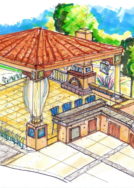Childhood is often looked at as a temporary condition resolved by time so for obvious reasons most everything that we build or make is for full-grown humans. Through the eyes of a child the natural environment can evoke a variety of emotions; but looking back at my childhood it was scale, the size of things, that look so different as an adult. Every object seemed big to me, larger than life, people as well. Obviously, I was small guy at the time, but they made a big impression. Conversely, through the eyes of an adult, objects like homes and buildings had remained the same physical size but seemed to shrunk in scale and stature, and had evolved. These nuances of scale would shape my thoughts later on in life particularly when designing and building when children were involved.
What kind of impression does scale make on a child’s mind, and how does it affect their development? I don’t know exactly, but I do remember struggling over a fence too high that may have affected the course of my life; not sure. Amongst my pals, I always seemed to be the last kid over the fence, unable to scale the 4’ high chain link. It was a big deal to me at the time because I thought that jumping the fence would gain me favor within my pack of playmates. My futile attempts would end with me hanging by my tee shirt at the top of the fence, needing to be rescued. I eventually made it over without problem. I had to wait to grow. I easily hopped over it as an adult; but that old chain link fence still tried to grab my shoe lace as my foot went over the top as if to say, “Remember me punk, got you again.”
I’ve found the behavior of children similar, but not always the same. Children can be curious, rambunctious, safety seekers, shade lovers, excavators, playhouse rats, amateur gardeners, the list goes on. When designing, it’s important to think like a child and to keep that connection to childhood thoughts and experiences. It’s necessary get up close, like peering through a hidden camera, or following along on a Go Pro observing each nuance as children move through their world. It is necessary that function be addressed honestly in all design situations, but especially where children are a constant presence.
Indeed, on the surface childhood seems like a temporary condition, a short period in our lives that moves so slowly and makes a big impression; these childhood impressions often shape our opinions as adults. For this reason, it makes sense to fully consider the impact of scale upon a child’s thoughts, movements, and daily activities whenever attempting to design within a child’s environment.




